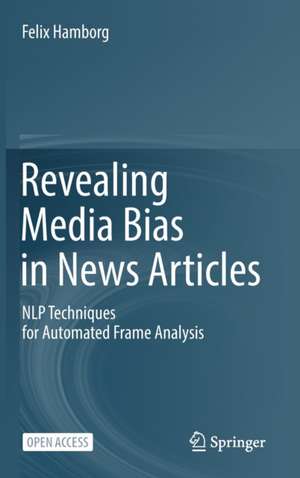Revealing Media Bias in News Articles: NLP Techniques for Automated Frame Analysis
Autor Felix Hamborgen Limba Engleză Hardback – 26 feb 2023
The book is structured in seven chapters: Chapter 1 presents a few of the severe problems caused by slanted news coverage and identifies the research gap that motivated the research described in this thesis. Chapter 2 discusses manual analysis concepts and exemplary studies from the social sciences and automated approaches, mostly from computer science and computational linguistics, to analyze and reveal media bias. This way, it identifies the strengths and weaknesses of current approaches for identifying and revealing media bias. Chapter 3 discusses the solution design space to address the identified research gap and introduces person-oriented framing analysis (PFA), a new approach to identify substantial frames and to reveal slanted news coverage. Chapters 4 and 5 detail target concept analysis and frame identification, the first and second component of PFA. Chapter 5 also introduces the first large-scale dataset and a novel model for target-dependent sentiment classification (TSC) in the news domain. Eventually, Chapter 6 introduces Newsalyze, a prototype system to reveal biases to non-expert news consumers by using the PFA approach. In the end, Chapter 7 summarizes the thesis and discusses the strengths and weaknesses of the thesis to derive ideas for future research on media bias.
This book mainly targets researchers and graduate students from computer science, computational linguistics, political science, and further social sciences who want to get an overview of the relevant state of the art in the other related disciplines and understand and tackle the issue of bias from a more effective, interdisciplinary viewpoint.
| Toate formatele și edițiile | Preț | Express |
|---|---|---|
| Paperback (1) | 301.77 lei 6-8 săpt. | |
| Springer Nature Switzerland – 26 feb 2023 | 301.77 lei 6-8 săpt. | |
| Hardback (1) | 365.00 lei 6-8 săpt. | |
| Springer Nature Switzerland – 26 feb 2023 | 365.00 lei 6-8 săpt. |
Preț: 365.00 lei
Preț vechi: 456.25 lei
-20% Nou
Puncte Express: 548
Preț estimativ în valută:
69.84€ • 73.11$ • 58.13£
69.84€ • 73.11$ • 58.13£
Carte tipărită la comandă
Livrare economică 31 martie-14 aprilie
Preluare comenzi: 021 569.72.76
Specificații
ISBN-13: 9783031176920
ISBN-10: 3031176928
Pagini: 238
Ilustrații: XIII, 238 p. 30 illus., 21 illus. in color.
Dimensiuni: 155 x 235 mm
Greutate: 0.53 kg
Ediția:1st ed. 2023
Editura: Springer Nature Switzerland
Colecția Springer
Locul publicării:Cham, Switzerland
ISBN-10: 3031176928
Pagini: 238
Ilustrații: XIII, 238 p. 30 illus., 21 illus. in color.
Dimensiuni: 155 x 235 mm
Greutate: 0.53 kg
Ediția:1st ed. 2023
Editura: Springer Nature Switzerland
Colecția Springer
Locul publicării:Cham, Switzerland
Cuprins
1. Introduction.- 2. Media Bias Analysis.- 3. Person-Oriented Framing Analysis.- 4. Target Concept Analysis.- 5. Frame Analysis.- 6. Prototype.- 7. Conclusion.
Notă biografică
Felix Hamborg is a research group leader at the Heidelberg Academy of Sciences and Humanities and a visiting researcher at the Humboldt University of Berlin, Germany. His research focuses on the automated identification of media bias in news articles and combines approaches from deep learning, natural language processing, information visualization, and political science. He completed his PhD at the University of Konstanz and was awarded several Best Paper / Outstanding Paper awards at renowned conferences like JCDL, CIKM, or the iConference.
Textul de pe ultima copertă
This open access book presents an interdisciplinary approach to reveal biases in English news articles reporting on a given political event. The approach named person-oriented framing analysis identifies the coverage’s different perspectives on the event by assessing how articles portray the persons involved in the event. In contrast to prior automated approaches, the identified frames are more meaningful and substantially present in person-oriented news coverage.
The book is structured in seven chapters: Chapter 1 presents a few of the severe problems caused by slanted news coverage and identifies the research gap that motivated the research described in this thesis. Chapter 2 discusses manual analysis concepts and exemplary studies from the social sciences and automated approaches, mostly from computer science and computational linguistics, to analyze and reveal media bias. This way, it identifies the strengths and weaknesses of current approaches for identifying and revealing media bias. Chapter 3 discusses the solution design space to address the identified research gap and introduces person-oriented framing analysis (PFA), a new approach to identify substantial frames and to reveal slanted news coverage. Chapters 4 and 5 detail target concept analysis and frame identification, the first and second component of PFA. Chapter 5 also introduces the first large-scale dataset and a novel model for target-dependent sentiment classification (TSC) in the news domain. Eventually, Chapter 6 introduces Newsalyze, a prototype system to reveal biases to non-expert news consumers by using the PFA approach. In the end, Chapter 7 summarizes the thesis and discusses the strengths and weaknesses of the thesis to derive ideas for future research on media bias.
This book mainly targets researchers and graduate students from computer science, computational linguistics, political science, and further social sciences who want to get an overview of the relevant state of the art inthe other related disciplines and understand and tackle the issue of bias from a more effective, interdisciplinary viewpoint.
This book mainly targets researchers and graduate students from computer science, computational linguistics, political science, and further social sciences who want to get an overview of the relevant state of the art inthe other related disciplines and understand and tackle the issue of bias from a more effective, interdisciplinary viewpoint.
Caracteristici
This book is open access, which means that you have free and unlimited access Presents an interdisciplinary approach to reveal biases in English news articles reporting on a given political event Introduces person-oriented framing analysis, an approach assessing how articles portray persons involved in the event Combines approaches from computer science, computational linguistics, and political science
